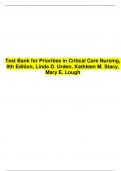Exam (elaborations)
Test Bank for Priorities in Critical Care Nursing, 9th Edition, Linda D. Urden, Kathleen M. Stacy, Mary E. Lough/ All Chapters With Correct Questions and Answers/A+
Test Bank for Priorities in Critical Care Nursing, 9th Edition, Linda D. Urden, Kathleen M. Stacy, Mary E. Lough/ All Chapters With Correct Questions and Answers/A+
[Show more]











